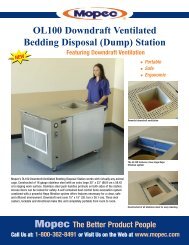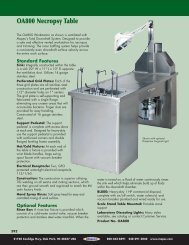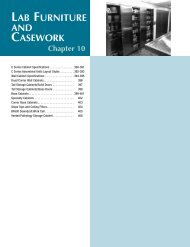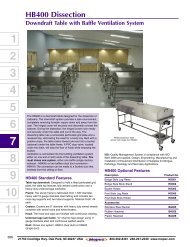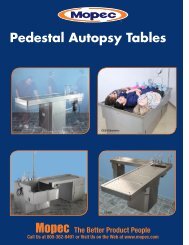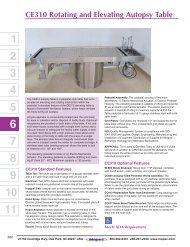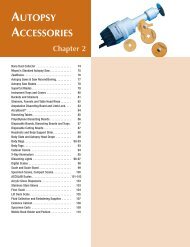your real life risks when using scalpel blades everyday - Mopec
your real life risks when using scalpel blades everyday - Mopec
your real life risks when using scalpel blades everyday - Mopec
Create successful ePaper yourself
Turn your PDF publications into a flip-book with our unique Google optimized e-Paper software.
What do these<br />
people have in<br />
common<br />
Apart from that they all work in the medical field like you v1.0
www.mopec.com<br />
Order Number AJ150<br />
YOUR REAL LIFE RISKS WHEN USING<br />
SCALPEL BLADES EVERYDAY
Order Number AJ150<br />
AREAS OF BLADEFLASK USE<br />
Dental Surgery<br />
Private Medical Practices<br />
Laboratories<br />
Medical Schools<br />
Mortuary<br />
Pathology<br />
Podiatry<br />
Veterinary surgery
AREAS OF INJURY AND INFECTION RISK<br />
Order Number AJ150<br />
• Nurse working in an ICU was stuck by an I.V. catheter used on a patient with end-stage<br />
AIDS; she was infected with HIV as a result<br />
– Advances in Exposure Prevention – Vol.7, No.7, 2005, p.25<br />
• Nurse infected with hepatitis C (HCV) from a blood exposure sustained at work<br />
– Advances in Exopsure Prevention – Vol.5, No.2, 2000, p.13<br />
• Laboratory worker acquired West Nile Virus Infection from a cut to his thumb from a<br />
<strong>scalpel</strong> blade<br />
– Advances in Exposure Prevention – Vol.6, No.5, 2003, p.59<br />
• Firefighter/Paramedic infected with HIV; he sustained massive blood and body fluids<br />
exposures on a number occasions during his nine years as a paramedic<br />
– Advances in Exposure Prevention – Vol.6, No.1, 2002, p.14<br />
• Surgeon diagnosed with HCV infection, from an occupational sharps injury<br />
– Advances in Exposure Prevention – Vol.6, No.5, 2003, p.49<br />
• Mortuary Embalmers – 39% reported needlestick in past 12 months (1991), 3%<br />
percutaneous injuries had exposures to AIDS patients<br />
– Journal of Occupational Medicine – Vol.33, No.8, August 1991, p.874<br />
• 11 US and Canadian veterinary schools reported 1-5 <strong>scalpel</strong>/knife cuts<br />
– Langley, R.L. et al. (1996) A Survey of Peronsl and Occupational Health and Safety Training for US and Canadian<br />
Veterinary Schools. Journal of Agromedicine, Vol.3, Iss.4 December 1996, p.23-25<br />
• A survey for dental students showed that the majority of injuries were from needlesticks<br />
and mishaps with hands instruments.<br />
– Wood, A.J. et.al. (2006) Student Occupational Exposure Incidence: Perception Versus Reality. Journal of Dental<br />
Education 70(10): 1081-1088.<br />
• All healthcare workers face a low but <strong>real</strong> risk of occupational infection from HIV<br />
exposure<br />
– Advances in Exposure Prevention – Vol.4, No.4, 1999, p.43
Order Number AJ150<br />
OUR ULTIMATE AIM / TAKE HOME MESSAGE<br />
To inform you that staff safety and patient safety are<br />
no longer mutually exclusive<br />
Yesterday’s thinking<br />
STAFF<br />
SAFETY<br />
PATIENT<br />
SAFETY<br />
Today’s thinking<br />
STAFF<br />
SAFETY<br />
PATIENT<br />
SAFETY<br />
Tomorrow’s thinking<br />
(congruent thinking)<br />
SAFETY<br />
FOR<br />
ALL<br />
STAFF<br />
SAFETY<br />
PATIENT<br />
SAFETY
Order Number AJ150<br />
COST AND CONFUSION<br />
OF A SCALPEL INJURY<br />
… and don‟t forget the personal cost
Order Number AJ150<br />
What is the WORST thing<br />
that can happen to you<br />
from a sharps injury
Order Number AJ150
OCCUPATIONAL SHARP INJURIES -<br />
INFECTED<br />
Order Number AJ150<br />
Diane Mawyer<br />
Virginia RN<br />
Diagnosed Hep C: 1993<br />
Lisa Arnold<br />
Pennsylvania, RN<br />
Diagnosed HIV: 1993<br />
Lisa Black<br />
Nevada, RN<br />
Diagnosed HIV & Hep C: 1998<br />
William Fisher<br />
US Surgeon:<br />
Diagnosed Hep C 2002
Order Number AJ150<br />
OTHER EXAMPLES IN DIFFERENT FIELDS<br />
Adapted from Surveillance of Occupationally Acquired HIV/AIDS in Healthcare Personnel, as of December 2006. URL:<br />
http://www.cdc.gov/ncidod/dhqp/bp_hcp_w_hiv.html
Order Number AJ150<br />
WHAT IS THE ‘LEAST WORST’ THING<br />
THAT CAN HAPPEN TO YOU<br />
Uncomplicated injury<br />
The cost of even an<br />
uncomplicated injury<br />
could range from $500 to<br />
$2,000<br />
And no sex for 3 months<br />
… how understanding will<br />
<strong>your</strong> partner be
Order Number AJ150<br />
SEVERED TENDON, ARTERY OR NERVE<br />
If the injury requires<br />
microsurgery, it might<br />
cost as much as<br />
$100,000<br />
Up to three months of<br />
rehabilitation<br />
Along with the loss of<br />
<strong>your</strong> salary<br />
Jagger, J., E. H. Hunt, et al. (1990). "Estimated cost of needlestick injuries for six major needled devices."<br />
Infect Control Hosp Epidemiol 11(11): 584-8.
COST OF AN INFECTION<br />
How confident are you that the hospital will pay<br />
Davis, M.S. (2004) “Take „Time Out‟ for Patient Safety and Worker Safety in the OR.”<br />
Advances in Exposure Prevention 7(2): 22-23.
Order Number AJ150<br />
SHARPS INJURY STATISTICS<br />
Remember it affects <strong>your</strong> whole family
Order Number AJ150<br />
INJURY FREQUENCY<br />
<br />
Healthcare workers in the United States report between 600,000 and 1 million<br />
sharps injuries per year 1<br />
70% of sharps injuries go unreported 1<br />
41% of sharp injuries occur after use and prior to disposal of a sharp device 2<br />
7-11% of sharps injuries are caused by <strong>scalpel</strong> <strong>blades</strong> 2<br />
<br />
<br />
Scalpel blade injuries are in the top five common type of sharps injury and second<br />
only to needle-stick 3<br />
In operating rooms, <strong>scalpel</strong> blade injuries are the second most common type of<br />
sharps injury, second only to suture needles 3<br />
1. Matson, K. (2000) "States begin passing sharps and needle-stick legislation to protect health care workers." AORN Journal 72(4):<br />
699-703, 705-7.<br />
2. "CDC (Centre for Disease Control and Prevention) Sharps Injury Prevention Workbook." from<br />
http://www.cdc.gov/SharpsSafety/workbook.html<br />
3. Jagger, J., M. Bentley, et al. (1998) "A study of patterns and prevention of blood exposures in OR personnel." AORN Journal 67(5):<br />
979-81, 983-4, 986-7 passim.
Order Number AJ150<br />
<br />
INFECTION RATES<br />
The chances of infection rates from a single contaminated<br />
needlestick or sharp instrument injury are as follows:<br />
HIV at 0.2% to 0.5%<br />
Currently there is no vaccine or treatment available to either prevent or<br />
cure HIV<br />
HBV at 30% (Hepatitis B)<br />
Post-exposure prophylaxis with hepatitis B immunoglobulin and initiation<br />
of hepatitis B vaccine is highly effective in preventing infection<br />
HCV at 3% to 10% (Hepatitis C)<br />
Currently no vaccines or cures for HCV and neither immunoglobulin nor<br />
antiviral therapy is recommended as post-exposure prophylaxis<br />
Of those infected with HCV, 85% develop an infection, 70% of whom<br />
develop liver disease which often leads to cirrhosis and liver transplants<br />
Culver, J. (1997). "Preventing transmission of blood-borne pathogens: a compelling argument for effective<br />
device-selection strategies." Am J Infect Control 25(5): 430-3.
FREQUENCY VS INCIDENCE<br />
SCALPELS VS NEEDLESTICK<br />
<br />
A study conducted by Eisenstein and Smith showed the<br />
incidence rates (per 100,000 devices) of puncture<br />
wounds by type of device:<br />
• Scalpel <strong>blades</strong>: 662<br />
• Disposable syringes and loose needles: 3.2<br />
Eisenstein, H. C. and D. A. Smith (1992). "Epidemiology of reported sharps injuries in a tertiary care<br />
hospital." J Hosp Infect 20(4): 271-80.\
HOW MANY SCALPEL INJURIES ARE<br />
PREVENTABLE<br />
<br />
Up to 50% of injuries are preventable<br />
Circumstances Associated with Scalpel Blade Injuries<br />
137<br />
Adapted from Fuentes et al “Scalpel Safety”: Modeling the effectiveness of different safety devices‟ ability to reduce <strong>scalpel</strong><br />
blade injuries. The International Journal of Risk & Safety in Medicine 2008; 20(1-2):83-89.
REGULATORY & LEGAL REQUIREMENTS
OSHA BLOODBORNE PATHOGENS GUIDELINES<br />
In 1991, OSHA issued the Bloodborne Pathogens<br />
Standard (29 CFR 1910.1030) to protect workers from<br />
this risk.<br />
“Must” requirements<br />
Needs to select safer devices<br />
Needs to involve employees in identifying and<br />
choosing devices<br />
Needs to maintain a log of injuries<br />
Citations
Order Number AJ150<br />
OSHA UPDATES - 2005<br />
OSHA interprets Bloodborne Pathogen Guidelines<br />
29 CFR 1910.1030(d)(1)(iv)(B) in 2005.<br />
<br />
"... that no one medical device is appropriate for use in all circumstances and<br />
that it is important to safeguard both patients and employees during medical<br />
and surgical procedures. If the use of a particular engineering control, in this<br />
case a safety <strong>scalpel</strong>, compromises patient safety, its use would not be<br />
considered feasible. The employer, therefore, must determine what engineering<br />
and work practice controls effectively minimize hazards without unduly<br />
interfering with medical procedures. The standard also recognizes that market<br />
availability is another limiting factor in implementing the use of engineering<br />
controls and must be considered in both <strong>your</strong> choice of an engineering control<br />
and our enforcement of their use [29 CFR 1910.1030(d)(1)(iv)(B)]. However,<br />
please be aware, exposures have been determined and where engineering<br />
controls are commercially available and feasible, they must be used."<br />
<br />
“The use of a single-handed <strong>scalpel</strong> blade remover meets these<br />
criteria”
Order Number AJ150<br />
OSHA UPDATES - 2008<br />
In 2008, OSHA clarifies further on this subject:<br />
• "... <strong>using</strong> fingers to remove a used <strong>scalpel</strong> blade does not meet the requirements of<br />
the standard."<br />
• "Some facilities use a two-handed procedure with hemostat as a mechanical device to<br />
remove <strong>scalpel</strong> <strong>blades</strong>... Hemostats have been used as a measure which was<br />
preferable to <strong>using</strong> fingers to remove a used <strong>scalpel</strong> blade. Employers are expected<br />
to consider and use safer and more effective measures <strong>when</strong> feasible."<br />
• "... suggestion that the BBP (bloodborne pathogen) standard be changed to require<br />
that if a mechanical device is utilized, it must be a 'one-handed use of a mechanicaldevice'<br />
is a very good recommendation and one that would improve worker safety."
Order Number AJ150<br />
OSHA UPDATES - SUMMARY<br />
Now equivalent to the Australian and New Zealand Standards (AS/NZS 3825:1998)
Order Number AJ150<br />
SPECIAL RISK IN PRIVATE PRACTICE<br />
Risk of doctor to patient transmission can end a<br />
career instantly<br />
CDC quote of the dentist in FL<br />
MS notes, Uni of Virginia and CDC in Atlanta<br />
Newspaper article from QLD on the dentist
Order Number AJ150<br />
<br />
COMMON LAW<br />
In addition to any legislative requirements, owners and employers<br />
are also required by common law principles to ensure that they<br />
are not negligent in connection with the use of needles and other<br />
sharps in a facility.<br />
<br />
<br />
The common law (essentially the precedents established by the<br />
courts over the centuries) requires that an owner or employer<br />
owes a duty of care to an employee to provide a safe working<br />
environment; the standard of care has been determined to<br />
dictate that an owner or employer must demonstrate a<br />
reasonable standard of safety having regard for other owners or<br />
employers in similar circumstances.<br />
The failure to meet the standard can give rise to a claim for<br />
damages arising from the negligent conduct of the owner or<br />
employer.<br />
J. Scott Weese and Douglas C. Jack (2008) "Needlestick injuries in veterinary medicine" Can Vet J. 2008<br />
August; 49(8): 780–784. URL: www.pubmedcentral.nih.gov/articlerender.fcgiartid=2465782
Order Number AJ150<br />
<br />
WHY DO YOU HAVE COMPLIANCE PROBLEMS<br />
SURGEONS MOSTLY HATE SAFETY SCALPELS<br />
‘Why surgeons are ref<strong>using</strong> to adopt safety <strong>scalpel</strong>s’.<br />
From Outpatient Surgery Magazine (Dec 2007)<br />
Surgeons resist safety <strong>scalpel</strong> for the reasons listed below:<br />
• They are too light<br />
• Too cumbersome to activate<br />
• More slippery than textured metal<br />
One orthopaedic surgeon stated that the safety sheath prevents him<br />
from cutting deeply enough, the <strong>scalpel</strong> does not fit into his hand like<br />
he’s used to and he was worried that he would cut himself trying to<br />
activate the device. “I don’t see any benefit to safety <strong>scalpel</strong>s. If it was to<br />
my or my patient’s advantage to use a safety <strong>scalpel</strong>, I would do it<br />
without hesitation. But having something bulky between you and the end<br />
of the blade that can hang on tissue and doesn’t let you control the knife<br />
the way you want to, it interferes with the operation.<br />
<br />
98% of surgeons surveyed in 30 hospitals from USA and Australia<br />
dislike safety <strong>scalpel</strong>s and prefer traditional handles
Order Number AJ150<br />
WHY DO YOU HAVE COMPLIANCE PROBLEMS<br />
SAFETY SCALPELS DANGEROUS<br />
<br />
EPINet (Exposure Prevention Information Network) data published<br />
in 2003 by Perry et al.3 In Fig. 1 of their article noted in the year<br />
2000-2001, 91 injuries caused by reusable <strong>scalpel</strong>s and 42<br />
injuries caused by disposable <strong>scalpel</strong>s (described elsewhere in<br />
the text as safety <strong>scalpel</strong>s). This was incorrectly interpreted as<br />
evidence to support use of safety <strong>scalpel</strong>s.<br />
<br />
However, according to Dr. Sheila Dunn, president and CEO of the<br />
consulting firm Quality America (personal communication) in<br />
2000-2001 90% of <strong>scalpel</strong>s in use in America were reusable<br />
handles and only 10% were safety <strong>scalpel</strong>s.<br />
“Relative incidence of injuries four times higher for<br />
safety <strong>scalpel</strong>s than for reusable <strong>scalpel</strong> handles.”<br />
Sinnott M, Wall D, „„SCALPEL SAFETY‟‟: How safe (or dangerous) are safety <strong>scalpel</strong>s, Int J Surg (2007),<br />
doi:10.1016/j.ijsu.2007.01.010
NOW YOU HAVE A CHOICE<br />
Order Number AJ150
Order Number AJ150<br />
COMPLIANCE MADE EASY<br />
PASSIVE SAFETY<br />
<br />
Passive Safety is automatic safety<br />
E.g. spring loaded safety syringe<br />
Or single-handed blade remover<br />
• Active Safety requires user to do<br />
something<br />
– E.g. sheath style safety syringe<br />
– Or safety <strong>scalpel</strong><br />
• CDC studies show active safety devices were not<br />
activated in up to 90% of cases – failing to<br />
protect the staff <strong>using</strong> them<br />
Passive Safety = Superior Safety<br />
Active Safety = Inferior Safety
Order Number AJ150<br />
HOSPITAL ACCREDITATION MADE EASY<br />
Joint Commission Article (March 2009)<br />
<br />
“I believe that the traditional <strong>scalpel</strong> handle will remain the first choice of the<br />
surgeon and that to ensure staff safety, a single-handed <strong>scalpel</strong> blade<br />
remover and hands-free passing technique will become the norm in all<br />
operating suites in the next five years,”…
Order Number AJ150<br />
BALANCING BUDGETS<br />
Without ignoring staff safety
COST SAVINGS<br />
1 BladeFlask + <strong>scalpel</strong> <strong>blades</strong> is cheaper than 100 safety <strong>scalpel</strong>s<br />
1 safety <strong>scalpel</strong> ranges from<br />
$1.50 - $3.70 each (Avg $2.60)<br />
1 BladeFlask costs $25 (removes 100<br />
<strong>blades</strong>, cost per blade removal $0.25)<br />
Cost per <strong>scalpel</strong> blade $0.10 (on avg)<br />
1 BladeFlask at $25 + 100 <strong>scalpel</strong> <strong>blades</strong> at $10 = $35<br />
is much better value than<br />
100 safety <strong>scalpel</strong>s ($2.60 x 100) = $260<br />
You save $225 (on average) with every BladeFlask you buy<br />
and you are up to 5 times SAFER<br />
and at least 98% of surgeons will be kept happy
MAKING COMPLIANCE<br />
A PRACTICAL REALITY
FEATURES AND BENEFITS<br />
<br />
<br />
<br />
Small & compact – saves space!<br />
Single-handed Activation<br />
Compliant with Regulatory requirements<br />
Compatible with <strong>blades</strong> from all commonly<br />
used reusable handles<br />
Built in counter with shut-off mechanism<br />
Removes <strong>blades</strong> in a „Click‟<br />
Audible „Click‟ sound signifies that blade has been captured.
Order Number AJ150<br />
TECHNICAL SPECIFICATIONS<br />
The Qlicksmart BladeFlask has been tested and is suitable for use with <strong>blades</strong>* <strong>using</strong> the commonly<br />
used handles.<br />
Compatible Handles:<br />
All commonly used handles: #3, #3L, #4, #4L, #5, #7, #9, Lawton Long Handle**<br />
Compatible Blade sizes:<br />
All commonly used <strong>blades</strong>: #10, #10A, #11, #12, #13, etc. up to and including #25A, #27 and<br />
#36<br />
Other brands of handles are constantly being tested. Qlicksmart would be happy to test any <strong>scalpel</strong><br />
handles you use - for more information please contact <strong>Mopec</strong>.<br />
Incompatible <strong>blades</strong> & handles<br />
Qlicksmart BladeFlask can NOT be used with the following handles:<br />
Beaver handle<br />
Disposable handles<br />
Baron handle<br />
* Qlicksmart BladeFlask’s functionality is limited by the length of blade. The maximum<br />
blade length tested is #36.<br />
** Some brands of handles may not work well with the Qlicksmart BladeFlask due to the<br />
shape and slope of the handle tang.
INSTRUCTIONS FOR USE<br />
Order Number AJ150
Order Number AJ150<br />
You now have a choice<br />
PREVENTION WHEN THERE IS NO CURE
Order Number AJ150<br />
Why do we need<br />
Scalpel Blade Removers <br />
98% of surgeons prefer steel handles<br />
>40% of cut to nurses / 3 months off work<br />
Minimum $5,000 worth of blood tests<br />
Or years of interferon and anti-retroviral<br />
US$10 million lawsuit
Order Number AJ150<br />
Order Today!<br />
21750 Coolidge Highway<br />
Oak Park MI 48237 (USA)<br />
www.mopec.com<br />
800-362-8491



